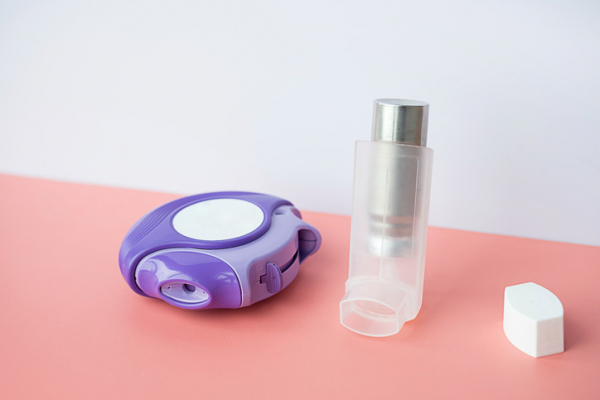
Which migraine medications are most helpful?

If you suffer from the throbbing, intense pain set off by migraine headaches, you may well wonder which medicines are most likely to offer relief. A recent study suggests a class of drugs called triptans are the most helpful option, with one particular drug rising to the top.
The study drew on real-world data gleaned from more than three million entries on My Migraine Buddy, a free smartphone app. The app lets users track their migraine attacks and rate the helpfulness of any medications they take.
Dr. Elizabeth Loder, professor of neurology at Harvard Medical School and chief of the Division of Headache at Brigham and Women’s Hospital, helped break down what the researchers looked at and learned that could benefit anyone with migraines.
What did the migraine study look at?
Published in the journal Neurology, the study included self-reported data from about 278,000 people (mostly women) over a six-year period that ended in July 2020. Using the app, participants rated migraine treatments they used as “helpful,” “somewhat helpful,” or “unhelpful.”
The researchers looked at 25 medications from seven drug classes to see which were most helpful for easing migraines. After triptans, the next most helpful drug classes were ergots such as dihydroergotamine (Migranal, Trudhesa) and anti-emetics such as promethazine (Phenergan). The latter help ease nausea, another common migraine symptom.
“I’m always happy to see studies conducted in a real-world setting, and this one is very clever,” says Dr. Loder. The results validate current guideline recommendations for treating migraines, which rank triptans as a first-line choice. “If you had asked me to sit down and make a list of the most helpful migraine medications, it would be very similar to what this study found,” she says.
What else did the study show about migraine pain relievers?
Ibuprofen, an over-the-counter pain reliever sold as Advil and Motrin, was the most frequently used medication in the study. But participants rated it “helpful” only 42% of the time. Only acetaminophen (Tylenol) was less helpful, helping just 37% of the time. A common combination medication containing aspirin, acetaminophen, and caffeine (sold under the brand name Excedrin) worked only slightly better than ibuprofen, or about half the time.
When researchers compared helpfulness of other drugs to ibuprofen, they found:
- Triptans scored five to six times more helpful than ibuprofen. The highest ranked drug, eletriptan, helped 78% of the time. Other triptans, including zolmitriptan (Zomig) and sumatriptan (Imitrex), were helpful 74% and 72% of the time, respectively. In practice, notes Dr. Loder, eletriptan seems to be just a tad better than the other triptans.
- Ergots were rated as three times more helpful than ibuprofen.
- Anti-emetics were 2.5 times as helpful as ibuprofen.
Do people take more than one medicine to ease migraine symptoms?
In this study, two-thirds of migraine attacks were treated with just one drug. About a quarter of the study participants used two drugs, and a smaller number used three or more drugs.
However, researchers weren’t able to tease out the sequence of when people took the drugs. And with anti-nausea drugs, it’s not clear if people were rating their helpfulness on nausea rather than headache, Dr. Loder points out. But it’s a good reminder that for many people who have migraines, nausea and vomiting are a big problem. When that’s the case, different drug formulations can help.
Are pills the only option for migraine relief?
No. For the headache, people can use a nasal spray or injectable version of a triptan rather than pills. Pre-filled syringes, which are injected into the thigh, stomach, or upper arm, are underused among people who have very rapid-onset migraines, says Dr. Loder. “For these people, injectable triptans are a game changer because pills don’t work as fast and might not stay down,” she says.
For nausea, the anti-emetic ondansetron (Zofran) is very effective, but one of the side effects is headache. You’re better off using promethazine or prochlorperazine (Compazine), both of which treat nausea but also help ease headache pain, says Dr. Loder.
Additionally, many anti-nausea drugs are available as rectal suppositories. This is especially helpful for people who have “crash” migraines, which often cause people to wake up vomiting with a migraine, she adds.
What are the limitations of this migraine study?
The data didn’t include information about the timing, sequence, formulation, or dosage of the medications. It also omitted two classes of newer migraine medications — known as gepants and ditans — because there was only limited data on them at the time of the study. These options include
- atogepant (Qulipta) and rimegepant (Nurtec)
- lasmiditan (Reyvow).
“But based on my clinical experience, I don’t think that any of these drugs would do a lot better than the triptans,” says Dr. Loder.
Another shortcoming is the study population: a selected group of people who are able and motivated to use a migraine smartphone app. That suggests their headaches are probably worse than the average person, but that’s exactly the population for whom this information is needed, says Dr. Loder.
“Migraines are most common in young, healthy people who are trying to work and raise children,” she says. It’s good to know that people using this app rate triptans highly, because from a medical point of view, these drugs are well tolerated and have few side effects, she adds.
Are there other helpful takeaways?
Yes. In the study, nearly half the participants said their pain wasn’t adequately treated. A third reported using more than one medicine to manage their migraines.
If you experience these problems, consult a health care provider who can help you find a more effective therapy. “If you’re using over-the-counter drugs, consider trying a prescription triptan,” Dr. Loder says. If nausea and vomiting are a problem for you, be sure to have an anti-nausea drug on hand.
She also recommends using the Migraine Buddy app or the Canadian Migraine Tracker app (both are free), which many of her patients find helpful for tracking their headaches and triggers.
About the Author

Julie Corliss, Executive Editor, Harvard Heart Letter
Julie Corliss is the executive editor of the Harvard Heart Letter. Before working at Harvard, she was a medical writer and editor at HealthNews, a consumer newsletter affiliated with The New England Journal of Medicine. She … See Full Bio View all posts by Julie Corliss
About the Reviewer

Howard E. LeWine, MD, Chief Medical Editor, Harvard Health Publishing
Dr. Howard LeWine is a practicing internist at Brigham and Women’s Hospital in Boston, Chief Medical Editor at Harvard Health Publishing, and editor in chief of Harvard Men’s Health Watch. See Full Bio View all posts by Howard E. LeWine, MD

Still confused after Flovent discontinuation? What to know and do

What happens when a widely used medicine is no longer available at pharmacies across the US? Until recently, Flovent (fluticasone) inhalers were frequently prescribed to help control asthma. If you or your child relied on these products, you may be scrambling to find medicines that will help you stay healthy without breaking the bank.
What’s essential to know, and what questions should you ask your health care provider? We checked in with Dr. William B. Feldman, a physician in the Division of Pulmonary and Critical Care Medicine at Harvard-affiliated Brigham and Women’s Hospital to get answers.
Which medicines are discontinued?
In January, GlaxoSmithKline stopped producing Flovent, which was available as a prescription metered-dose inhaler (Flovent HFA) and a dry powder inhaler (Flovent Diskus).
Both contain fluticasone, a steroid. Fluticasone reduces inflammation and swelling in the airways. Both types of inhalers are FDA-approved to help prevent asthma attacks.
However, children under age 5 and adults with particularly poor lung function may not be able to use a dry powder inhaler. They may lack the lung power necessary to breathe in deeply enough to pull the medicine into their airways, Dr. Feldman explains. A metered-dose inhaler could be the best choice for them.
Now that Flovent is discontinued, is a generic product available?
Yes, the drug manufacturer has licensed an authorized generic of both Flovent products: the metered-dose inhaler and the dry powder inhaler.
However, insurance coverage may not pay for the authorized generic because it may cost an insurer more than some other branded medicines. So, you may need to switch to another brand to stay healthy. Call your insurance company to check.
What are your alternatives?
This is a good chance for you and your doctor to review your asthma treatment plan. It may be a good time to make changes.
If you had been using Flovent daily for symptom control, your doctor may recommend:
- Trying an inhaled steroid similar to Flovent. Many types of steroids will work, including beclomethasone (Qvar RediHaler), budesonide (Pulmicort Flexhaler), ciclesonide (Alvesco), and mometasone (Asmanex Twisthaler, Asmanex HFA). “These products use different molecules to do the same job as fluticasone,” says Dr. Feldman.
- Switching to a combination inhaler. New studies suggest this approach may help many people who use Flovent daily for symptom control and only use a short-acting medicine to open airways when an asthma flare occurs (see here and here). If you have intermittent asthma symptoms, talk with your provider about whether you could use a combination inhaler when you start to wheeze or have shortness of breath. This combines a medicine called formoterol with a steroid. Symbicort provides this combination in one inhaler. Although not yet approved by the FDA for this specific use, it is approved in many other countries.
What else do asthma specialists advise people to do?
If your insurance covers the authorized generic, this may be a good choice because you already know how to use the product. But what if insurance won’t cover this?
“Any other inhaled steroid should work for most — but not all — people,” says Dr. Feldman. “There are brand-name metered-dose and dry powder inhalers available, such as those mentioned above.”
Here’s what else to know and do
- Discuss whether it’s safe to switch medicines or type of device. For many people, the answer will be yes. But if your health care provider believes that a metered-dose inhaler is the best choice due to age or poor lung function, ask your insurance company for a formulary exception to cover the authorized generic fluticasone or another metered-dose inhaler. Ask your provider to make the same request.
- If you have a child under 5, you and your doctor should also ask your insurance company for a formulary exception to cover a metered-dose inhaler with a steroid.
- For anyone who needs to switch brands, your new inhaler may look and feel different and may require a new technique when you use it to get the full benefit of the medicine. “When folks switch from one type of inhaler to another, it’s very important to get proper education, ideally from their prescriber. But you can also do this online to understand how to properly use this new product,” says Dr. Feldman.
If you do switch, ask your health care provider to show you how to use the new inhaler in an in-person or virtual visit. If that’s not possible, check your technique by watching these videos created by National Jewish Health, a leading US hospital for respiratory care.
What if you’re not feeling as good on a new asthma medicine?
If you’ve switched and notice worsening symptoms or more asthma attacks, contact your health care provider, Dr. Feldman advises. “They should make sure this isn’t due to improper technique with the new device. It may not be, but it’s important to check and to keep your doctor aware of changes like these.”
Is there a difference between an authorized generic and independent generic medicines?
“With an authorized generic, the brand-name company produces the generic or licenses another company to do that. It’s the exact same medicine as the original brand-name drug. It just doesn’t have the label,” says Dr. Feldman.
Independent generics encourage price competition if several companies make them. “With authorized generics, you don’t see those price decreases to the same extent, because you typically just have one product and it’s totally controlled by the branded company,” he adds.
What if you don’t have insurance, or insurance won’t cover a medicine you need?
“These inhalers have extraordinarily high list prices — $200, $300, $400 per month for the product,” notes Dr. Feldman. Manufacturers negotiate rebates with insurers that may substantially lower the price for an insurance plan.
If you don’t have insurance, you won’t get that lower price. So, it’s worth checking prices for all options: you may find the authorized generic will cost you less than other brand-name inhalers.
About the Author

Francesca Coltrera, Editor, Harvard Health Blog
Francesca Coltrera is editor of the Harvard Health Blog, and a senior content writer and editor for Harvard Health Publishing. She is an award-winning medical writer and co-author of Living Through Breast Cancer and The Breast … See Full Bio View all posts by Francesca Coltrera
About the Reviewer

Howard E. LeWine, MD, Chief Medical Editor, Harvard Health Publishing
Dr. Howard LeWine is a practicing internist at Brigham and Women’s Hospital in Boston, Chief Medical Editor at Harvard Health Publishing, and editor in chief of Harvard Men’s Health Watch. See Full Bio View all posts by Howard E. LeWine, MD